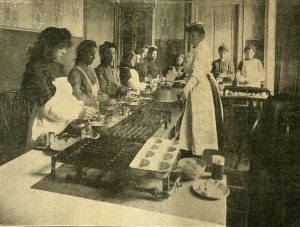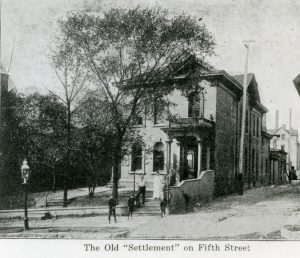The first American settlement house was established in New York City in 1886. In contrast to existing charitable organizations that dispensed material aid and advice to the needy, in settlement houses reformers lived in the neighborhoods they served with cultural programming and community amenities. College-educated men and women joined the settlement house movement around the United States to live and work among the poor. From 1890 to 1920, the American settlement movement grew rapidly. Within the context of a rise of nativism that culminated in restrictive immigration legislation, settlement house workers targeted various urban problems brought on by industrialization and increased immigration. Settlement house workers believed that it would not be possible to transform the neighborhood without first reforming urban society by working for better education and labor standards, housing improvements, and health care initiatives.
Milwaukee’s early settlement houses were guided by tenets of social science research, as settlement house workers adopted investigative methods to study and ameliorate the causes of poverty, crime, and juvenile delinquency. At the turn of the century, sociologists at the University of Wisconsin identified portions of Milwaukee’s Fourteenth Ward on the South Side as having the city’s highest rate of infant mortality, crime, and juvenile delinquency. The ward was also one of the most congested residential areas populated by newly-arrived Polish, Russian, Lithuanian, and Slovakian immigrant families. In November of 1902, the Wisconsin University Settlement House was established to serve this community under the leadership of Reverend Herbert H. Jacobs and Mary Belle Jacobs. The fifteen-member Board of Directors of the settlement included ten members from Milwaukee and five members with “active association” with the University of Wisconsin. Although the settlement was not directly funded by the university, it received contributions from the Settlement League of the University of Wisconsin.[1]
The University of Wisconsin Settlement House occupied the “old Coleman residence” on First Avenue adjacent to Kosciuszko Park. Renting at $50 per month, the settlement consisted of a basement with a laundry, a carpentry shop, a room to conduct cooking classes, a handball court, a library, a nurse’s quarters, and over sixteen bedrooms.[2] Residing in the settlement house, Reverend Jacobs and other workers offered a broad range of programs for their immigrant neighbors, including social clubs, instructional classes, and a night school for adults. Home economics students from Milwaukee-Downer College taught sewing and cooking classes, and the Outdoor Art Association taught children gardening. The Settlement Association acquired, ownership of the house located at 861 First Avenue in 1908 through a gift from Margaret W. Allis. In 1916, the Milwaukee Community Fund took over operational costs for supporting the Settlement. By 1921, the settlement reached 500 families each week as the children’s department of the settlement grew to include drama, folk dancing, and music classes as well as a variety of sports clubs.[3]
By the turn of the century, established religious and ethnic groups borrowed from the national settlement movement to create their own social settlements in Milwaukee. The most well-known was established in 1896 when Lizzie Black Kander and a group of Jewish clubwomen opened a settlement house for their newly arrived Eastern European compatriots in a space contributed by Milwaukee’s Temple B’ne Jeshurun and Temple Emanu-El. The Ladies Relief Sewing Society, which later evolved into the Milwaukee Jewish Mission, established basic aid services as well as added a bathhouse for immigrants in 1896. “The Keep Clean Mission,” located next to the Schlitz Brewery, piped in excess water from sterilized beer bottles for an immigrant bathhouse. On March 27, 1900, the women of the Mission united with the Sisterhood of Personal Service to form, “The Settlement.” Kander was named president of the settlement house located at 507 Fifth Street. She served in this position from 1900 to 1918. In 1904, the Settlement moved to 499 Fifth Street; and again moved in 1907, relocating on the Lower East Side of Milwaukee. The settlement provided classes on sewing, cooking, and English. Clubs included the Young Judaea Council, the “Buds of Zion,” and the “Maccabees.” In three years, the expanding services of the settlement increased the need for space. With proceeds from the sale of The Settlement Cook Book, the newly-built Abraham Lincoln House opened its doors on November 11, 1910. By 1931, the Abraham Lincoln Settlement became known as the Jewish Community Center located on Prospect Avenue on Milwaukee’s East Side.[4]
Initially, Milwaukee’s settlement houses drew its recruits from the upper-middle class, white men and women. But by the mid-twentieth century, increased awareness of deteriorating housing conditions, educational inequality, and urban decay led some of Milwaukee’s African-American leaders to draw upon tenets of the settlement house movement to develop “neighborhood centers” with the goal of revitalizing the inner city through community organization. Neighborhood centers drew on the tradition of settlement houses without the mandate that workers live on site; staff were paid professionals rather than residential volunteers. Incorporated in April 1961 by the East Wisconsin Conference of the Women’s Society of Christian Service of the United Methodist Church, the Northcott Neighborhood House was located at the southern edge of the Hillside Housing Project at 1523 North Sixth Street. Led by the Reverend Lucius Walker, the Northcott Neighborhood House was created for “religious, charitable, and education purposes” to “lessen neighborhood tensions, combat community deterioration and juvenile delinquency” as well as “perform other social work” on “behalf of persons in the Milwaukee, Wisconsin community.”[5] The neighborhood center organized a range of services and programs, including a tutoring program for illiterate adults, a children’s day camp, a second-hand clothing shop, a doll library, and a comprehensive health care screening service.[6] Throughout its history, Northcott partnered with the University of Wisconsin-Milwaukee for assistance in educational program development for children and adults on Milwaukee’s North Side. By the mid-1960s the neighborhood center joined forced with the city’s civil rights organizations to work toward programs that fostered equal opportunity and social justice through community organizing. Northcott joined forces with community organizations to establish a Planned Parenthood Clinic, to gain representation on Milwaukee’s Community Relations-Social Development Commission, and to partner with other inner-city groups to write economic development grants.[7]
Of the course of the twentieth century, Milwaukee’s settlement house staffs supported state labor laws, including worker’s compensation and minimum wage legislation, establishing vital health care services and educational programs as well as creating the foundation for organized social work in the city. Settlements were not only a center for social reform but a focal point for political action as leaders responded to the immediate needs and concerns of Milwaukee’s most underrepresented communities.
Footnotes [+]
- ^ Ruth Harman and Charlotte Lekachman, “The Jacobs’ House,” Wisconsin Magazine of History 16, no. 3 (March 1933): 261-63, last accessed September 3, 2017.
- ^ Harman and Lekachman, “The Jacobs’ House,” 260-61.
- ^ Harman and Lekachman, “The Jacobs’ House,” 264-65, 267-68.
- ^ Angela Fritz, “Lizzie Black Kander & Culinary Reform in Milwaukee, 1880-1920,” Wisconsin Magazine of History 87, no. 3 (Spring 2004), 43-45.
- ^ Fielding Utz, “Northcott Neighborhood House,” Milwaukee History 6 (Winter 1983): 115-16.
- ^ Utz, “Northcott Neighborhood House,” 117.
- ^ Utz, “Northcott Neighborhood House,” 121, 123.
For Further Reading
Fritz, Angela. “Lizzie Black Kander & Culinary Reform in Milwaukee, 1880-1920.” Wisconsin Magazine of History v 87, no. 3 (Spring 2004): 36-49.
Harman, Ruth and Charlotte Lekachman. “The Jacobs’ House.” Wisconsin Magazine of History 16, no. 3 (March 1933): 252-84.
McBride, Genevieve. On Wisconsin Women: Working for Their Rights from Settlement to Suffrage. Madison, WI: University of Wisconsin Press, 1993.
Salisbury, Winifred. “Letters from the Settlement House.” Milwaukee History 19, no. 2: 54-68.
Utz, Fielding. “Northcott Neighborhood House.” Milwaukee History 6 (Winter 1983): 115-124.



0 Comments
Please keep your community civil. All comments must follow the Encyclopedia of Milwaukee Community rules and terms of use, and will be moderated prior to posting. Encyclopedia of Milwaukee reserves the right to use the comments we receive, in whole or in part, and to use the commenter's name and location, in any medium. See also the Copyright, Privacy, and Terms & Conditions.
Have a suggestion for a new topic? Please use the Site Contact Form.